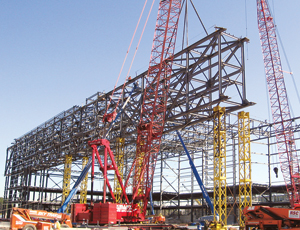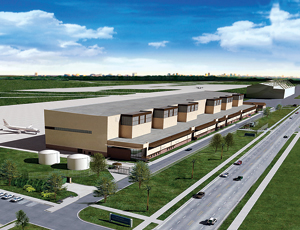With just two months until scheduled completion, contractors at the Naval Air Station in Jacksonville, Fla., are putting finishing touches on the U.S. Navy’s largest hangar, which is being built to make room for five squadrons coming from Maine under the government’s Base Realignment and Closure program.
Mortenson Construction Co., Minneapolis, is the design-builder for the $127.7-million project under a multiple award construction contract with the Navy. The scope of work includes clearing more than 40 acres and demolishing base housing that occupied the site, decommissioning three storm water retention ponds and constructing a 275,000-sq-ft hangar, with fire-water storage tanks, 1.1 million sq ft of 14-in.-thick apron paving and a new 10-acre wet detention pond.
The hangar sits on sandy clay, supported by 401 auger cast piles, 14 in. and 24 in. in diameter, with the larger piles typically 60 ft deep. The air station is on the bank of Florida’s largest river, the St. Johns, so groundwater is high, about 5 ft below grade. Utilities include more than a mile of duct bank for power and communications, three lift stations and taxiway lighting and extensive underground piping for storm water management.
The Type II hangar measures 985 x 214 ft, will withstand winds up to 120 mph and features two of the Navy’s longest clear spans, 434 ft and 458 ft. Construction challenges included the fast track schedule, procurement of materials and erection of the box trusses for the clear spans, say the project’s participants. Kansas City-based Butler Heavy Steel designed the structural frame in a collaboration with architect-engineer HNTB Federal Services Corp., Washington, D.C., the AE of record. “It’s very conventional steel framing,” says Kevin Lewis, architectural practice leader, but the clear spans presented challenges of design and erection.
There are hangars with larger clear spans. Magnusson Klemencic Associates, Seattle, designed a 488-ft clear span in Detroit, and Thornton Tomasetti, New York City, designed one with spans of 600 and 725 ft for New Doha International Airport. But “this was the largest clear span that Butler has ever done,” says Dan Talbott, Butler project engineering manager. “We had to make sure we had the cambering correct.” Lt. Cdr. Steven Mauro, the Navy’s public works officer for the project, calls that engineering “one of the most significant parts of the work.” Procurement also proved surprisingly hard. “It took six months to get some shapes from the mill,” Talbott says. He never learned why that was so hard, but believes heavy demand for the Beijing Olympics facilities played a part.
Erection of the clear span began at the center core, “a pretty substantial structure in itself,” says Curtis Mayes, reconstruction and engineering director for LPR Construction Co., Loveland, Colo., the steel-erection subcontractor. LPR assembled the box trusses on site. A Manitowoc 2250 crane erected the first segment, weighing 157,000 lb, on the core, cantilevered out 71 ft, 9 in. Shoring towers that were 51 ft, 10 in. tall supported the other 12 truss modules as the spans were extended in each direction from the center core. The crane supported the first section for seven hours before it was cut out, but support time for the final section was reduced to four to five hours, says Greg Fossett, Mortenson project manager.






















Post a comment to this article
Report Abusive Comment